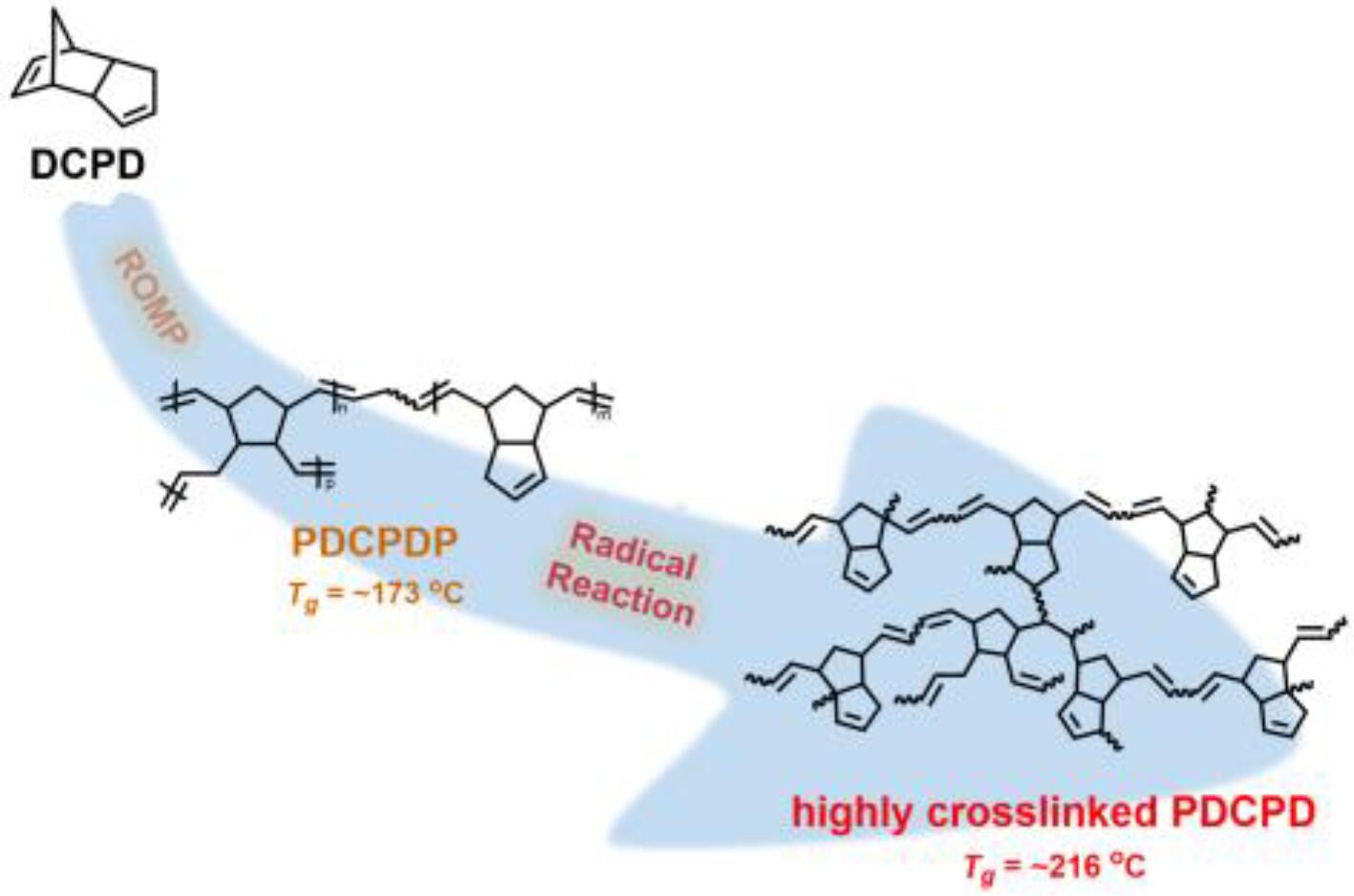求助PDF
{"title":"通过顺序 ROMP 和自由基反应实现性能优越的聚双环戊二烯","authors":"Qingyan Zhan, Fei Huangfu, Po Yang","doi":"10.1002/pi.6619","DOIUrl":null,"url":null,"abstract":"<p>Herein, we develop an approach to achieve performance-advantaged polydicyclopentadiene (PDCPD) via sequential ring-opening metathesis polymerization (ROMP) and radical reactions. We mix dicyclopentadiene (DCPD), Grubbs' catalyst and radical initiator in one pot, and then polymerize first at low temperature by ROMP and initiate radical reactions at elevated temperature. As a result of our strategy, the crosslink density of PDCPD increases, leading to outstanding performance. For instance, the glass transition temperature <i>T</i><sub>g</sub> of ROMP-prepared PDCPD is <i>ca</i> 155–175 °C, whereas the <i>T</i><sub>g</sub> of PDCPD prepared by this strategy can be increased to 191 °C and can be further enhanced to 216 °C after polymerization at 250 °C. We believe this can help researchers design and synthesize high performance ROMP-derived polymers and apply PDCPD in harsh conditions. © 2024 Society of Industrial Chemistry.</p>","PeriodicalId":20404,"journal":{"name":"Polymer International","volume":"73 6","pages":"464-470"},"PeriodicalIF":2.9000,"publicationDate":"2024-02-16","publicationTypes":"Journal Article","fieldsOfStudy":null,"isOpenAccess":false,"openAccessPdf":"","citationCount":"0","resultStr":"{\"title\":\"Achieving performance-advantaged polydicyclopentadiene via sequential ring-opening metathesis polymerization and radical reaction\",\"authors\":\"Qingyan Zhan, Fei Huangfu, Po Yang\",\"doi\":\"10.1002/pi.6619\",\"DOIUrl\":null,\"url\":null,\"abstract\":\"<p>Herein, we develop an approach to achieve performance-advantaged polydicyclopentadiene (PDCPD) via sequential ring-opening metathesis polymerization (ROMP) and radical reactions. We mix dicyclopentadiene (DCPD), Grubbs' catalyst and radical initiator in one pot, and then polymerize first at low temperature by ROMP and initiate radical reactions at elevated temperature. As a result of our strategy, the crosslink density of PDCPD increases, leading to outstanding performance. For instance, the glass transition temperature <i>T</i><sub>g</sub> of ROMP-prepared PDCPD is <i>ca</i> 155–175 °C, whereas the <i>T</i><sub>g</sub> of PDCPD prepared by this strategy can be increased to 191 °C and can be further enhanced to 216 °C after polymerization at 250 °C. We believe this can help researchers design and synthesize high performance ROMP-derived polymers and apply PDCPD in harsh conditions. © 2024 Society of Industrial Chemistry.</p>\",\"PeriodicalId\":20404,\"journal\":{\"name\":\"Polymer International\",\"volume\":\"73 6\",\"pages\":\"464-470\"},\"PeriodicalIF\":2.9000,\"publicationDate\":\"2024-02-16\",\"publicationTypes\":\"Journal Article\",\"fieldsOfStudy\":null,\"isOpenAccess\":false,\"openAccessPdf\":\"\",\"citationCount\":\"0\",\"resultStr\":null,\"platform\":\"Semanticscholar\",\"paperid\":null,\"PeriodicalName\":\"Polymer International\",\"FirstCategoryId\":\"92\",\"ListUrlMain\":\"https://onlinelibrary.wiley.com/doi/10.1002/pi.6619\",\"RegionNum\":4,\"RegionCategory\":\"化学\",\"ArticlePicture\":[],\"TitleCN\":null,\"AbstractTextCN\":null,\"PMCID\":null,\"EPubDate\":\"\",\"PubModel\":\"\",\"JCR\":\"Q2\",\"JCRName\":\"POLYMER SCIENCE\",\"Score\":null,\"Total\":0}","platform":"Semanticscholar","paperid":null,"PeriodicalName":"Polymer International","FirstCategoryId":"92","ListUrlMain":"https://onlinelibrary.wiley.com/doi/10.1002/pi.6619","RegionNum":4,"RegionCategory":"化学","ArticlePicture":[],"TitleCN":null,"AbstractTextCN":null,"PMCID":null,"EPubDate":"","PubModel":"","JCR":"Q2","JCRName":"POLYMER SCIENCE","Score":null,"Total":0}
引用次数: 0
引用
批量引用



